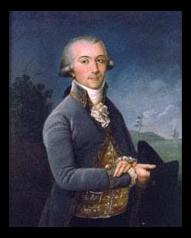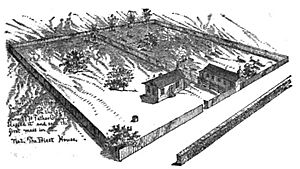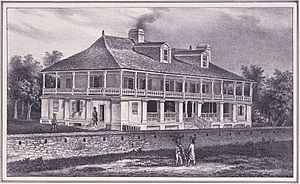Auguste Chouteau facts for kids
Quick facts for kids
Auguste Chouteau
|
|
|---|---|
 |
|
| Born | September 7, 1749 |
| Died | February 24, 1829 (aged 79) St. Louis, Missouri, United States
|
| Signature | |
 |
|
René-Auguste Chouteau, Jr. (born September 7, 1749, or September 26, 1750 – died February 24, 1829), known as Auguste Chouteau, was a very important person in the early history of St. Louis, Missouri. He helped found the city and became a successful fur trader and a politician.
Auguste Chouteau and his business partner had a special agreement for many years. They were the only ones allowed to trade furs with the large Osage tribe along the Missouri River. He also had many other businesses in St. Louis. He was well-connected with the different governments that ruled the area: first the French, then the Spanish, and finally the Americans.
Contents
Auguste Chouteau's Early Life and Learning
Auguste Chouteau was born in New Orleans. His mother was Marie-Thérèse Bourgeois. His father was René Auguste Chouteau. Auguste was their only child.
When Auguste was about eight years old, his mother, Marie-Thérèse, began living with Pierre de Laclède Liguest. People often called him Laclede. Laclede became like a stepfather to Auguste. He made sure Auguste received a good education, possibly in a Catholic school in New Orleans.
Even as a young teenager, Auguste showed a strong interest in learning. He likely learned a lot directly from Laclede. By the early 1760s, Auguste was already helping Laclede with his business. He helped get supplies and worked as a clerk. He even joined Laclede on a trip up the Mississippi River to set up a new fur-trading post.
Many historians believe Auguste's mother, Marie-Thérèse, also played a big role in his life. She was very smart and had a strong business sense. She helped him develop the skills that made him successful later on.
Founding of St. Louis
In the early 1760s, Laclede and his business partner decided to build a French trading post. It would be on the west side of the Mississippi River. This spot was north of another village called Ste. Genevieve, Missouri. They started buying supplies in 1763. On July 6, 1763, they got a special permit from the French government. This permit allowed them to trade with Native American tribes.
In August 1763, Chouteau, Laclede, and about 30 other men traveled upriver from New Orleans. They brought many goods for trading. By November, they reached Sainte Geneviève. But Laclede found that the village wasn't a good place to store his goods. It was too close to the river and often flooded.
The French soldiers at Fort de Chartres, across the river, agreed to store the goods. This was because the French were about to give control of the fort to the British. Laclede decided to create a whole new community, not just a trading post. He hoped many French settlers would move there.
Laclede planned to store the goods until spring. Then, Chouteau and his team would build the trading post. Laclede told Chouteau, "You will come here as soon as the river is clear, and you will clear this place. We will build our settlement here, following the plan I will give you."
In February 1764, Chouteau led a group of 30 men across the river. They landed on February 14. The very next day, February 15, Chouteau directed the men to start clearing the land. This is how the European city of St. Louis was founded. This area had been home to indigenous tribes for a long time. There were many large earthwork mounds left from the Mississippian culture.
Laclede joined them in April. He helped convince French settlers from other villages to move to the new settlement. Within a few months, Laclede built a home for Marie-Thérèse. She arrived in St. Louis in September 1764. Auguste Chouteau lived in this home until he died. Marie-Thérèse and Laclede had four more children together. One of them was Jean Pierre Chouteau. He later became a business and political partner with Auguste.
After Laclede died in 1778, Chouteau took over the trading business. He made the family very wealthy. He expanded the business to include farms and banking. He also owned one of the first flour mills in St. Louis. This mill was built along Mill Creek. Chouteau's Pond, created by the mill, was a popular spot until 1852. Chouteau also helped other towns grow, like St. Charles, Missouri.
Chouteau kept good relationships with the Spanish government in St. Louis. In 1780, he helped defend the village during the Battle of St. Louis. The village was attacked by British-led Native American groups. Chouteau talked with the Spanish government to get better defenses for the city. For his efforts, he was made a captain and later a colonel.
Growing the Fur Trade Business
In the early 1780s, Auguste Chouteau was key to trade between St. Louis and Native American tribes. He worked to keep peace and encourage trade. He and his brother, Pierre, built many trading forts along the Missouri River.
His connection with the Osage Nation became very important. In 1787, the Spanish governor ordered an end to trade with the Osage. He was preparing for war because of fighting between the Osage and European settlers. Even though the government banned trade, Chouteau helped prevent a conflict. He talked with the governor and the Osage.
Despite ongoing problems between the Osage and the Spanish, Chouteau kept good relations with the tribe. The trade ban was lifted in 1791. But problems continued between tribes and settlers.
In 1793, the Spanish Governor General ordered all trade to stop. He also planned a military attack against the Osage and other tribes. However, Chouteau led an Osage group to New Orleans in 1794. He convinced the Governor General to make peace. Chouteau promised to build a military fort among the Osage at his own cost. In return, Chouteau received a six-year special right to trade along the Osage River.
The fort, called Fort Carondelet, was built in 1795. It was a military base, but it was also a trading post for the Chouteau family. Chouteau's nephews lived there and learned valuable trading skills. Through this fort, Chouteau also arranged to build another trading post. This one was among the Osage on the Verdigris River in eastern Kansas.
In 1799, a new Spanish Governor General started favoring a Spanish businessman. Fort Carondelet was sold to the Spanish company. But Chouteau continued trading with the Osage on the Verdigris.
However, the Spanish competition didn't last long. The Louisiana Territory was given to France in 1800, then sold to the United States in 1803. Late that year, Chouteau gave important information to the Lewis and Clark Expedition. He told them about the people living in the Louisiana territory. He also shared observations about wildlife and local villages.
In early 1804, Lewis and Clark bought supplies from Chouteau's trading house in St. Louis. On March 9, 1804, Chouteau hosted the new American commander. This was during the ceremonies when the Louisiana Purchase officially transferred the land. Because of his help, Chouteau was given back his special trading rights with the tribes by the United States.
From 1806 to 1815, Chouteau continued to lead his family's fur trade business. He helped negotiate parts of the Treaties of Portage des Sioux in 1815, after the War of 1812. In 1816, Auguste Chouteau retired from his trading businesses. He remained active in Native American issues. In 1817, he served as a U.S. Commissioner of Indian Affairs. He worked with William Clark on the first U.S. treaty with the Ponca tribe.
Auguste Chouteau's Family and Death
Auguste Chouteau lived in the St. Louis area. However, he often took long trading trips up the Missouri River to his trading posts. He traded mostly with the Osage.
On September 21, 1786, Chouteau married Marie Therese Cerre. She was the daughter of Jean-Gabriel Cerré, another important person in St. Louis. Their marriage brought together two of the leading families in the city. It was also a happy marriage. They were known for being very welcoming and hospitable. This helped strengthen his position in the city and region.
Auguste Chouteau died on February 24, 1829. He was first buried near the Basilica of St. Louis. Later, his remains were moved to Calvary Cemetery.
Auguste Chouteau and Marie Therese Cerre had seven children:
- Auguste Aristide Chouteau (1792–1833), who became a fur trader.
- Gabriel Chouteau (1794–1887), who served in the War of 1812.
- Marie Thérèse Eulalie Chouteau (1799–1835), who married René Paul, the first surveyor of St. Louis.
- Henry Chouteau (1805–55), a railroad executive.
- Edward Chouteau (1807–46), a trader.
- Louise Chouteau, who married Gabriel Paul.
- Emilie Chouteau, who married Thomas Floyd, an officer in the Black Hawk War.
See also
 In Spanish: Auguste Chouteau para niños
In Spanish: Auguste Chouteau para niños




